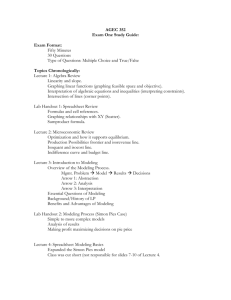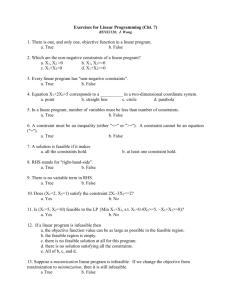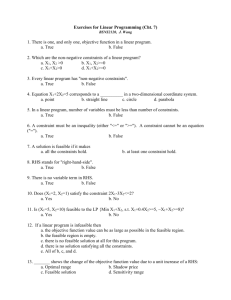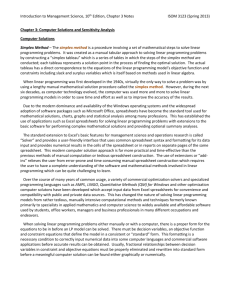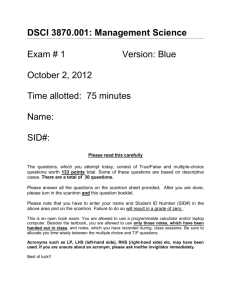Linear Programming: Models, Formulation & Sensitivity Analysis
advertisement
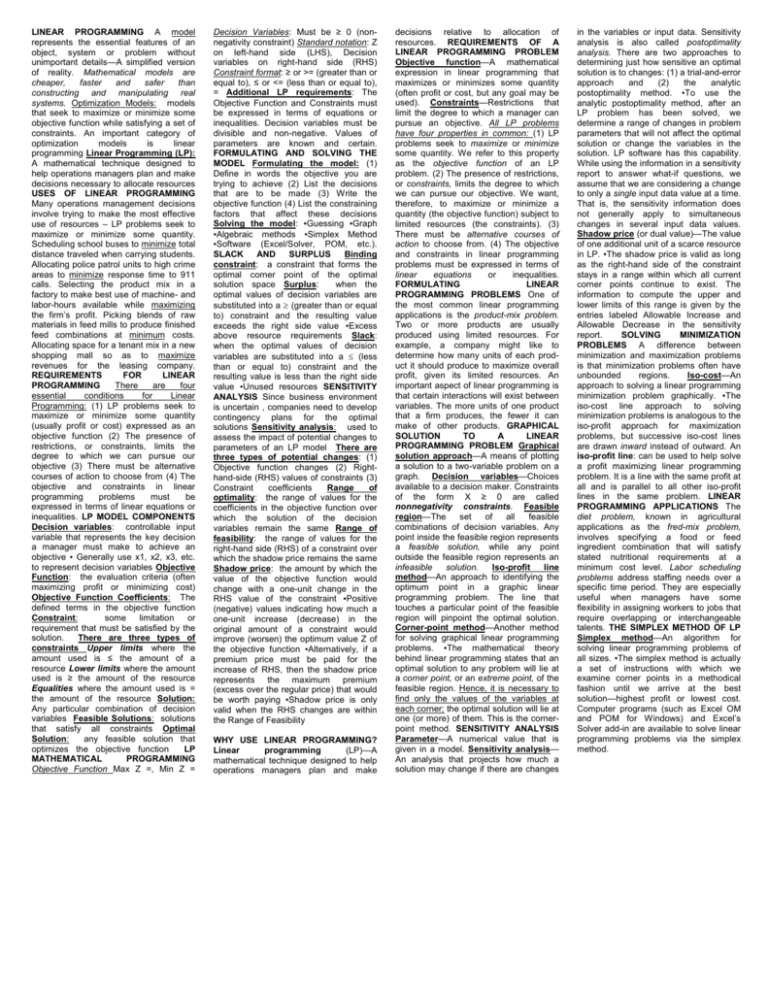
LINEAR PROGRAMMING A model represents the essential features of an object, system or problem without unimportant details—A simplified version of reality. Mathematical models are cheaper, faster and safer than constructing and manipulating real systems. Optimization Models: models that seek to maximize or minimize some objective function while satisfying a set of constraints. An important category of optimization models is linear programming Linear Programming (LP): A mathematical technique designed to help operations managers plan and make decisions necessary to allocate resources USES OF LINEAR PROGRAMMING Many operations management decisions involve trying to make the most effective use of resources – LP problems seek to maximize or minimize some quantity. Scheduling school buses to minimize total distance traveled when carrying students. Allocating police patrol units to high crime areas to minimize response time to 911 calls. Selecting the product mix in a factory to make best use of machine- and labor-hours available while maximizing the firm’s profit. Picking blends of raw materials in feed mills to produce finished feed combinations at minimum costs. Allocating space for a tenant mix in a new shopping mall so as to maximize revenues for the leasing company. REQUIREMENTS FOR LINEAR PROGRAMMING There are four essential conditions for Linear Programming: (1) LP problems seek to maximize or minimize some quantity (usually profit or cost) expressed as an objective function (2) The presence of restrictions, or constraints, limits the degree to which we can pursue our objective (3) There must be alternative courses of action to choose from (4) The objective and constraints in linear programming problems must be expressed in terms of linear equations or inequalities. LP MODEL COMPONENTS Decision variables: controllable input variable that represents the key decision a manager must make to achieve an objective ▪ Generally use x1, x2, x3, etc. to represent decision variables Objective Function: the evaluation criteria (often maximizing profit or minimizing cost) Objective Function Coefficients: The defined terms in the objective function Constraint: some limitation or requirement that must be satisfied by the solution. There are three types of constraints Upper limits where the amount used is ≤ the amount of a resource Lower limits where the amount used is ≥ the amount of the resource Equalities where the amount used is = the amount of the resource Solution: Any particular combination of decision variables Feasible Solutions: solutions that satisfy all constraints Optimal Solution: any feasible solution that optimizes the objective function LP MATHEMATICAL PROGRAMMING Objective Function Max Z =, Min Z = Decision Variables: Must be ≥ 0 (nonnegativity constraint) Standard notation: Z on left-hand side (LHS), Decision variables on right-hand side (RHS) Constraint format: ≥ or >= (greater than or equal to), ≤ or <= (less than or equal to), = Additional LP requirements: The Objective Function and Constraints must be expressed in terms of equations or inequalities. Decision variables must be divisible and non-negative. Values of parameters are known and certain. FORMULATING AND SOLVING THE MODEL Formulating the model: (1) Define in words the objective you are trying to achieve (2) List the decisions that are to be made (3) Write the objective function (4) List the constraining factors that affect these decisions Solving the model: ▪Guessing ▪Graph ▪Algebraic methods ▪Simplex Method ▪Software (Excel/Solver, POM, etc.). SLACK AND SURPLUS Binding constraint: a constraint that forms the optimal corner point of the optimal solution space Surplus: when the optimal values of decision variables are substituted into a (greater than or equal to) constraint and the resulting value exceeds the right side value ▪Excess above resource requirements Slack: when the optimal values of decision variables are substituted into a (less than or equal to) constraint and the resulting value is less than the right side value ▪Unused resources SENSITIVITY ANALYSIS Since business environment is uncertain , companies need to develop contingency plans for the optimal solutions Sensitivity analysis: used to assess the impact of potential changes to parameters of an LP model There are three types of potential changes: (1) Objective function changes (2) Righthand-side (RHS) values of constraints (3) Constraint coefficients Range of optimality: the range of values for the coefficients in the objective function over which the solution of the decision variables remain the same Range of feasibility: the range of values for the right-hand side (RHS) of a constraint over which the shadow price remains the same Shadow price: the amount by which the value of the objective function would change with a one-unit change in the RHS value of the constraint ▪Positive (negative) values indicating how much a one-unit increase (decrease) in the original amount of a constraint would improve (worsen) the optimum value Z of the objective function ▪Alternatively, if a premium price must be paid for the increase of RHS, then the shadow price represents the maximum premium (excess over the regular price) that would be worth paying ▪Shadow price is only valid when the RHS changes are within the Range of Feasibility WHY USE LINEAR PROGRAMMING? Linear programming (LP)—A mathematical technique designed to help operations managers plan and make decisions relative to allocation of resources. REQUIREMENTS OF A LINEAR PROGRAMMING PROBLEM Objective function—A mathematical expression in linear programming that maximizes or minimizes some quantity (often profit or cost, but any goal may be used). Constraints—Restrictions that limit the degree to which a manager can pursue an objective. All LP problems have four properties in common: (1) LP problems seek to maximize or minimize some quantity. We refer to this property as the objective function of an LP problem. (2) The presence of restrictions, or constraints, limits the degree to which we can pursue our objective. We want, therefore, to maximize or minimize a quantity (the objective function) subject to limited resources (the constraints). (3) There must be alternative courses of action to choose from. (4) The objective and constraints in linear programming problems must be expressed in terms of linear equations or inequalities. FORMULATING LINEAR PROGRAMMING PROBLEMS One of the most common linear programming applications is the product-mix problem. Two or more products are usually produced using limited resources. For example, a company might like to determine how many units of each product it should produce to maximize overall profit, given its limited resources. An important aspect of linear programming is that certain interactions will exist between variables. The more units of one product that a firm produces, the fewer it can make of other products. GRAPHICAL SOLUTION TO A LINEAR PROGRAMMING PROBLEM Graphical solution approach—A means of plotting a solution to a two-variable problem on a graph. Decision variables—Choices available to a decision maker. Constraints of the form X ≥ 0 are called nonnegativity constraints. Feasible region—The set of all feasible combinations of decision variables. Any point inside the feasible region represents a feasible solution, while any point outside the feasible region represents an infeasible solution. Iso-profit line method—An approach to identifying the optimum point in a graphic linear programming problem. The line that touches a particular point of the feasible region will pinpoint the optimal solution. Corner-point method—Another method for solving graphical linear programming problems. ▪The mathematical theory behind linear programming states that an optimal solution to any problem will lie at a corner point, or an extreme point, of the feasible region. Hence, it is necessary to find only the values of the variables at each corner; the optimal solution will lie at one (or more) of them. This is the cornerpoint method. SENSITIVITY ANALYSIS Parameter—A numerical value that is given in a model. Sensitivity analysis— An analysis that projects how much a solution may change if there are changes in the variables or input data. Sensitivity analysis is also called postoptimality analysis. There are two approaches to determining just how sensitive an optimal solution is to changes: (1) a trial-and-error approach and (2) the analytic postoptimality method. ▪To use the analytic postoptimality method, after an LP problem has been solved, we determine a range of changes in problem parameters that will not affect the optimal solution or change the variables in the solution. LP software has this capability. While using the information in a sensitivity report to answer what-if questions, we assume that we are considering a change to only a single input data value at a time. That is, the sensitivity information does not generally apply to simultaneous changes in several input data values. Shadow price (or dual value)—The value of one additional unit of a scarce resource in LP. ▪The shadow price is valid as long as the right-hand side of the constraint stays in a range within which all current corner points continue to exist. The information to compute the upper and lower limits of this range is given by the entries labeled Allowable Increase and Allowable Decrease in the sensitivity report. SOLVING MINIMIZATION PROBLEMS A difference between minimization and maximization problems is that minimization problems often have unbounded regions. Iso-cost—An approach to solving a linear programming minimization problem graphically. ▪The iso-cost line approach to solving minimization problems is analogous to the iso-profit approach for maximization problems, but successive iso-cost lines are drawn inward instead of outward. An iso-profit line: can be used to help solve a profit maximizing linear programming problem. It is a line with the same profit at all and is parallel to all other iso-profit lines in the same problem. LINEAR PROGRAMMING APPLICATIONS The diet problem, known in agricultural applications as the fred-mix problem, involves specifying a food or feed ingredient combination that will satisfy stated nutritional requirements at a minimum cost level. Labor scheduling problems address staffing needs over a specific time period. They are especially useful when managers have some flexibility in assigning workers to jobs that require overlapping or interchangeable talents. THE SIMPLEX METHOD OF LP Simplex method—An algorithm for solving linear programming problems of all sizes. ▪The simplex method is actually a set of instructions with which we examine corner points in a methodical fashion until we arrive at the best solution—highest profit or lowest cost. Computer programs (such as Excel OM and POM for Windows) and Excel’s Solver add-in are available to solve linear programming problems via the simplex method.


